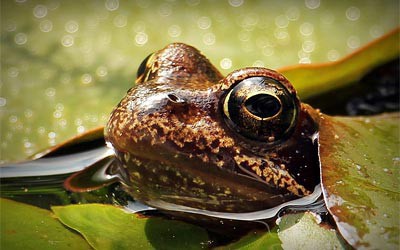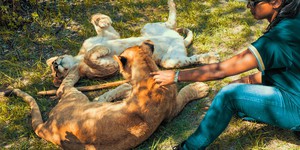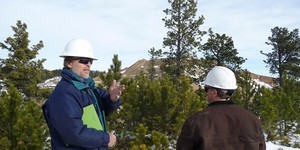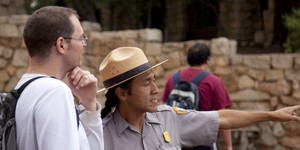Abstract
Have you ever heard the expression "a canary in a coal mine"? In the 1900's and earlier, coal miners brought canaries with them into the mines to act as early warning signals. The canaries were very sensitive to low levels of dangerous gases, so if the birds stopped singing, or got sick, then the miners knew to leave immediately, even if they felt fine. As it turns out, our froggy friends are also very helpful at signaling problems, not in mines, but in and around bodies of water. Try this environmental science fair project to find out how.Summary
Kristin Strong, Science Buddies

Objective
To determine the percentage of malformed frogs in a local pond and determine if it is greater than what is expected for a healthy pond.
Introduction
So what kind of animal leaps up and surprises you like a jack-in-the-box, has a voice far larger than its size, and wears that Mona Lisa smile? The frog! These amazing amphibians, found from the tropics to the sub-arctic regions, transform themselves over their life cycle, from water-breathing tadpoles to mostly air-breathing frogs. In the folklore of many cultures, frogs are seen as clumsy and unattractive, but also as having transformative powers and hidden talents. (Remember the story of the frog that turns into a prince?) It turns out that the fairy tales have one thing right—frogs do have a special ability; one that is very important to humans. Frogs are an indicator species, which means they can alert humans to changes in the environment before humans are affected enough to notice the problems.
The frog's habitat of water and land, its metamorphosis from fish to frog, and its extraordinary skin are all responsible for its ability to act as an indicator species. For this science fair project, you'll focus on the skin, which is very thin and stretchy, kind of like a swimming suit. The most important feature of their skin, though, is that it's permeable to water and oxygen. This means that the skin allows water and oxygen to pass through, so frogs drink and breathe, in part, through their skin! When they are underwater, they can take in extra oxygen through their skin, and they don't ever need to drink through their mouths, because they can get all the moisture they need right through their skin, too. Frogs feel slimy because they secrete mucous that keeps their thin skin from drying out and helps prevent dehydration when the frogs are out of the water. Frogs must keep their skins moist at all times; otherwise, they won't get enough oxygen to survive. Frogs also shed their skin each week, in a process that looks a bit like dancing to "Twist and Shout." When they are done wriggling out of their skin, they eat it—frogs don't waste any bit of nutrition!
Frogs are very sensitive to changes in their water and land environments. Changes such as increased ultraviolet light (sunlight), pesticides or other chemicals, or parasites, can all contribute to errors in the frog's early development. When it is still a fertilized egg, cells and cell layers are "talking" to each other. These chemical conversations between the cells are what will form the parts of the tadpole, and then the parts of the frog, and they are controlled by genes.
If a change in the environment affects these conversations, or changes the genes, then malformations (meaning bad formations, like the failure to form a leg) can occur. These malformations can arise at any stage in the frog's development, but are most visible to people after the frog has gone through a dramatic process, called metamorphosis. Malformations can arise anywhere in the developmental process—going from fins to feet, from gills to lungs, from tailed to tail-less, from long intestines to short, from prey eyes to predator eyes—due to environmental changes that the frog cells experienced very early on in their development.
In 1995, middle school students on a field trip discovered that one-half of all the frogs they caught in a pond in southern Minnesota had malformations. Historically, in Minnesota, the baseline percentage of malformations had been only about 0.2 percent (based on frogs collected between 1958 and 1963 and stored in the state's Museum of Natural History). The baseline is the normal percentage of malformations that you would expect to find in a healthy pond, due primarily to genetic defects. The children and their teachers alerted state officials that 50 percent of the frogs in their pond had malformations, and the story became national news and started a national evaluation of frog malformations. A report that was published 5 years after the children's discovery, showed that 44 states had found excessive malformations among 38 different species of frogs.
In this environmental science fair project, you will evaluate the percentage of malformations and types of malformations in your local pond, and help national researchers track and study the global problems affecting frogs and other amphibians.
Terms and Concepts
- Frog
- Amphibian
- Tropics
- Sub-arctic
- Life cycle
- Tadpole
- Transformation
- Indicator species
- Habitat
- Metamorphosis
- Permeable
- Oxygen
- Sensitive
- Ultraviolet
- Pesticide
- Parasite
- Fertilized egg
- Gene
- Malformation
- Baseline
- Symmetry
- Asymmetry
- Surface runoff
- Contaminant
Questions
- What is the life cycle of a frog?
- How does a frog change during its life cycle?
- What environmental causes may be responsible for frog malformations?
Bibliography
This source describes the frog's amazing skin:
- Exploratorium. (1999). Frogs. Retrieved November 18, 2008.
This source provides a field guide to all types of frog malformations, with anatomical checklists that may be helpful to more-advanced students:
- Meteyer, C.U. (2000). Field Guide to Malformations of Frogs and Toads. May 16, 2023.
This science fair project was inspired by this resource:
- TPT. (2006). Frog Malformations by Susie and Katie. DragonflyTV, Twin Cities Public Television. Retrieved November 19, 2008.
For help creating graphs, try this website:
- National Center for Education Statistics (n.d.). Create a Graph. Retrieved May 23, 2008.
Materials and Equipment
- Access to a pond, lake, stream, or other waterway with many tadpoles and frogs
-
Volunteers to help you catch at least 100 frogs during one visit; your volunteers must include at least 1 adult (at least 1, but the more the better).
- Note: If your pond is "healthy," you won't see many malformations. Many volunteers is best, because the more frogs you can catch, the better your estimate of the true health of the pond.
- Dip nets (1 for each volunteer); available at sporting goods stores or from an online supplier such as Carolina Biological catalog #651344A
- Deep buckets (1 for every 2-3 volunteers)
- Camera; any kind of camera will work, but you might want to choose disposable cameras (3), if desired, since you will be taking photographs around water.
- Clothing and shoes (wading boots are ideal) that can get dirty. Be sure all of your volunteers know beforehand what they should be wearing and what will be involved.
- Access to a computer with Internet access
- Optional: Disposable gloves (1 pair for each volunteer). These can be purchased at a local drug store or pharmacy, or through an online supplier like Carolina Biological Supply Company. If any of your volunteers is allergic to latex, use vinyl or polyethylene gloves.
- Lab notebook
Disclaimer: Science Buddies participates in affiliate programs with Home Science Tools, Amazon.com, Carolina Biological, and Jameco Electronics. Proceeds from the affiliate programs help support Science Buddies, a 501(c)(3) public charity, and keep our resources free for everyone. Our top priority is student learning. If you have any comments (positive or negative) related to purchases you've made for science projects from recommendations on our site, please let us know. Write to us at scibuddy@sciencebuddies.org.
Experimental Procedure
Preparing for Your Experiment
- Go online and take a look at the United States Geological Survey's Field Guide to Malformations in Frogs and Toads to see examples of different types of malformations that you might find in frogs in your pond.
Collecting Your Frogs
- Once at the location, add 1–2 inches of pond water to each bucket and place the buckets in a cool, shady spot. The buckets will hold your frogs after you catch them and while you sort and evaluate them. The frogs must be kept moist and cool, or they will die.
- Have your volunteers put on their boots (and the latex gloves, too, if desired). Ask them to help you catch frogs as quickly as possible with the dip nets. Two or three volunteers should share a bucket. Have each volunteer group (of two or three people) keep count out loud as frogs are captured and transferred to their buckets. You can do some preparation beforehand, once you know how many volunteers will be helping, to figure out how many frogs each volunteer group should capture to reach at least 100.
- When at least 100 frogs have been caught (the more the better), sort them into two buckets. Handle the frogs gently and place the healthy-looking frogs in one bucket, and any malformed frogs in another. Count the number of healthy and malformed frogs as you sort them, and write down your final counts in your lab notebook.
- Take photographs of each malformed frog, and one representative photograph of a healthy frog for your display board.
- Return all the frogs gently and carefully to the pond, wash your hands, and ask your volunteers to do the same.
Analyzing Your Photographs
- Print out images of your malformed frog photographs, and sort them into asymmetrical and symmetrical malformations. To learn more about symmetry and asymmetry, and to see examples, visit the Spinning Your Wheels: Pinwheel Sensitivity Science Buddies project, or consult the United States Geological Survey's Field Guide to Malformations in Frogs and Toads.
- Sort your photographs further into limb (arm and leg) malformations, spine malformations, head malformations, eye malformations, skin malformations, those that have malformations in multiple parts, and those that have extra parts (like an extra limb). Count the number of each type of malformation, and enter your counts into a data table, similar to the one below.
| Type of Malformation | Limb | Spine | Head | Eye | Skin | Multiple Parts | Extra Parts | Total Count |
| Asymmetric | ||||||||
| Symmetric | ||||||||
| Percentage of malformations in the total number of frogs collected | Percent Asymmetric ______% | Percent Symmetric ______% | ||||||
| Percentage of Total Malformations ________% | ||||||||
-
Calculate the percentage of each type of malformation and enter it in the data table using Equation 1.
Equation 1:
% of malformations = (number of asymmetric malformations) + (number of symmetric malformations)
total number of frogs caught× 100
- An example to obtain the percentage of each type of malformation: Let's say 100 frogs were caught, and 20 of those frogs had asymmetric limb malformations, and 10 of those frogs had symmetric limb malformations. To calculate the percentage of frogs with limb malformations, add the asymmetric and symmetric numbers together (20+10=30). Then divide 30 total limb malformations by 100 total frogs, and multiply that number by 100, which equals 30 percent.
- An example to obtain the total count: If the total count of all asymmetric malformations is 50, and the total count of all symmetric malformations is 10, and 120 frogs were caught, then you would add the asymmetric and symmetric totals together (50+10=60). Then divide 60 total malformations by 120 total frogs and multiply by 100, which equals 50 percent.
- Create a bar chart showing the types of malformations on the x-axis, and the counts on the y-axis. Place symmetric and asymmetric counts side-by-side for each type of malformation. You can make the bar chart by hand or use a website like Create a Graph to make the chart on the computer and print it.
- Examine your data table. Was the total percentage of malformations greater than the expected baseline percentage of less than 0.5%? Which type of malformation was more common? Asymmetrical or symmetrical? Which type of body part was most commonly malformed in your pond? What do your results tell you about the health of the body of water that you investigated?
- Consider researching the most common malformation you observed, and see what environmental factor is the most likely cause. The Bibliography gives sources where you can share your findings with scientists.
Ask an Expert
Global Connections
The United Nations Sustainable Development Goals (UNSDGs) are a blueprint to achieve a better and more sustainable future for all.
Variations
- Evaluate two different nearby bodies of water and compare your data tables for each. If they vary greatly, consult topographical and business maps to determine if there are farms or factories nearby where surface runoff (excess water flowing over the land and picking up soil contaminants) could be affecting habitat and accounting for the differences in your data tables.
Careers
If you like this project, you might enjoy exploring these related careers:












